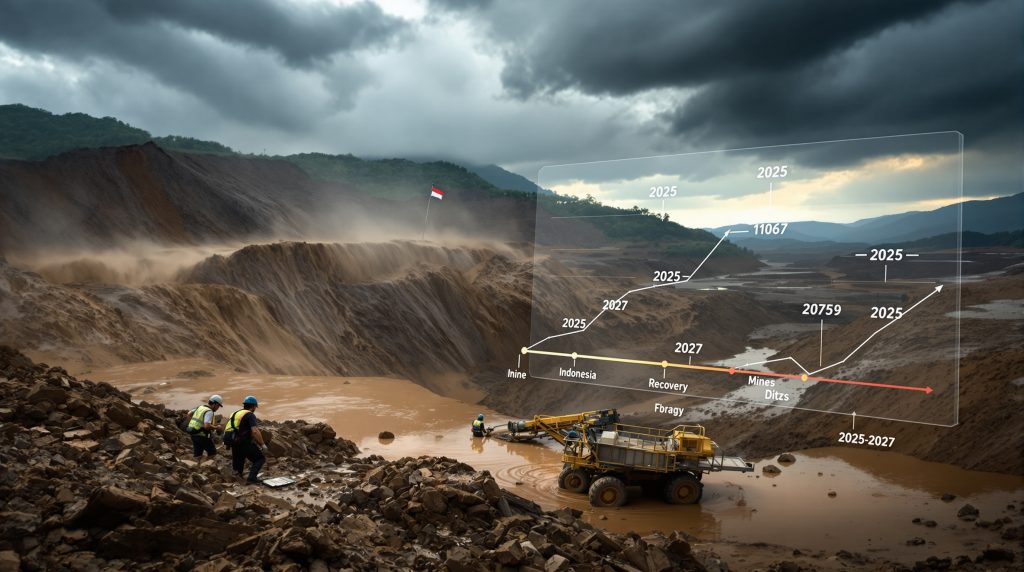The Grasberg Mine Disaster: Understanding the Fatal 2025 Incident
On September 8, 2025, Indonesia's mining industry faced one of its most tragic disasters when approximately 800,000 tonnes of waterlogged material surged from the former Grasberg open pit into active mining areas. This catastrophic event at the Grasberg mine in Papua province claimed the lives of seven workers and significantly disrupted global copper supply chains. The incident has raised important questions about mining safety practices and highlighted the strategic importance of this massive operation to global metal markets.
What Happened at the Grasberg Mine in 2025?
The disaster unfolded when a massive mud flow from the former Grasberg open pit rushed into the active underground mining operation. The waterlogged material affected multiple mine levels, with particular impact on the service level where seven workers were conducting development activities at the time of the incident.
The tragedy prompted an immediate suspension of all mining operations as emergency response teams launched an intensive search and rescue mission. For nearly a month, rescue workers navigated treacherous conditions in hopes of finding survivors trapped within the mine.
On October 7, 2025, after exhaustive search efforts, Freeport McMoRan, the mine's operator, confirmed the devastating news that all seven missing workers had perished in the disaster. The recovery of the final five bodies brought a somber conclusion to the search operation while highlighting the human cost of this industrial catastrophe.
The incident location in Tembagapura, Mimika Regency, Central Papua, presented significant challenges for rescue operations due to the remote location and complex underground environment. Local communities and mining industry professionals worldwide closely followed the search efforts, holding out hope until the tragic confirmation.
How Did the Disaster Impact Mining Operations?
Immediate Operational Consequences
The mud-flow disaster forced Freeport McMoRan to take several critical actions to address the emergency:
- Complete suspension of all mining operations at the Grasberg facility
- Declaration of force majeure, legally halting contractual obligations for copper and gold shipments
- Warning to stakeholders about significantly reduced production for Q3-Q4 2025
- Downward revision of production forecasts by approximately 35% for 2026
The company's immediate focus shifted entirely to search and rescue operations, with production concerns temporarily set aside during the emergency response phase. This operational shutdown instantly removed a significant portion of global copper production from the market.
Long-Term Recovery Timeline
The extensive damage to mine infrastructure has necessitated a carefully phased recovery plan:
| Recovery Phase | Timeline | Expected Activity |
|---|---|---|
| Initial Assessment | September-December 2025 | Investigation and safety evaluation |
| Limited Restart | Late 2025 | Resumption in unaffected sections |
| Grasberg Block Cave Restart | Early 2026 | Gradual ramp-up of main operations |
| Full Production Recovery | 2027 | Return to pre-incident output levels |
Industry analysts note that this extended timeline reflects the complexity and severity of the damage, with the mine not expected to return to full production capacity for approximately two years after the incident. The phased approach prioritizes safety while attempting to minimize long-term market disruption.
Why Is the Grasberg Mine Significant to Global Markets?
Strategic Importance
The Grasberg mine stands as one of the world's most strategically important mineral resources:
- Currently ranked as the world's second-largest copper producer
- One of the most significant gold producers globally
- Represents 50% of Freeport McMoRan's proven and probable reserves
- Accounts for 70% of the company's projected copper and gold output through 2029
The mine's exceptional mineral content makes it particularly valuable, with ore grades significantly higher than global averages. This concentration of minerals in a single location creates both opportunity and risk for the global supply chain.
Market Impact Assessment
The disruption at Grasberg is creating significant ripple effects throughout global commodity markets:
- Removal of nearly 600,000 tonnes of contained copper from global supply through 2026
- Upward pressure on copper prices, which were already approaching record highs
- Compounding effect on an already tight global copper market facing multiple disruptions
- Strategic reconsideration of global copper supply chains and inventory management
With copper being a critical component in renewable energy infrastructure, electric vehicles, and electronics, the timing of this supply disruption is particularly problematic. The copper demand surge and transition to clean energy technologies relies heavily on steady copper supplies, making this disruption potentially more impactful than similar events in previous decades.
What Caused the Grasberg Mine Disaster?
The exact cause of the September 2025 incident remains under investigation. Freeport has assembled a team that includes independent external experts to conduct a comprehensive root cause analysis. This investigation is examining:
- The structural integrity of the former open pit area and surrounding geological formations
- Water management systems and historical drainage practices in the region
- Effectiveness of early warning mechanisms and monitoring systems
- Operational protocols in high-risk development areas
- Potential contributing factors such as recent precipitation patterns
The company expects to conclude its investigation by the end of 2025, with findings to be shared with Indonesian authorities who are collaborating on the assessment. Preliminary observations suggest the volume and velocity of the material movement were unprecedented and potentially related to changing geological conditions in the former open pit area.
Mining experts have noted that underground mining adjacent to former open pit operations creates unique engineering challenges that require constant modern mine planning and risk assessment. The interface between these mining methods can create zones of instability if not properly managed.
How Does This Compare to Previous Mining Disasters?
Historical Context at Grasberg
This is not the first fatal incident at the Grasberg operation. In May 2013, the mine experienced a catastrophic roof collapse that resulted in 28 worker fatalities and 10 injuries during a safety training session. That incident led to serious questions about safety protocols and management practices.
The 2013 tragedy prompted significant safety reforms at the operation, including enhanced tunnel reinforcement protocols, expanded emergency response capabilities, and more rigorous safety training requirements. These improvements make the 2025 death of workers in Grasberg mine disaster particularly troubling, as it occurred despite these enhanced safety measures.
Global Mining Incidents in 2025
The Grasberg disaster occurred amid several other significant mining disruptions worldwide:
- A tunnel collapse at Chile's El Teniente mine claimed six lives
- Flooding affected operations at Ivanhoe Mines' Kakula operation in the DRC
- Operational challenges impacted production at Teck Resources and Anglo American
These concurrent incidents have collectively strained global copper supply chains and highlighted ongoing safety concerns across the mining sector. Industry observers note that the clustering of these events has intensified scrutiny of mining safety practices globally, with particular focus on operations in geologically complex environments.
What Are the Environmental Implications?
While the immediate focus has been on the human tragedy and operational impact, the environmental consequences of such a large-scale mud flow also warrant attention:
- Potential contamination of local water systems from disturbed mining materials
- Disruption to surrounding ecosystems and wildlife habitats
- Long-term remediation requirements for affected areas
- Regulatory implications for future operations
Environmental monitoring will be a significant component of both the investigation and recovery efforts. Local environmental advocacy groups have expressed concerns about potential water quality impacts on surrounding communities and ecosystems.
The incident highlights the complex environmental challenges faced in mining operations, particularly in environmentally sensitive regions. Papua's unique biodiversity makes environmental protection particularly important, and recovery efforts will need to address both operational and waste management solutions simultaneously.
How Will This Affect Indonesia's Mining Industry?
Regulatory Response
The Indonesian government's response to this disaster may include:
- Enhanced safety regulations for underground mining operations
- Increased scrutiny of foreign-operated mining ventures
- More rigorous environmental protection requirements
- Potential economic impacts on local communities dependent on the mine
Indonesia's Ministry of Energy and Mineral Resources has already announced a comprehensive review of safety protocols at all major mining operations in the country. This review is likely to result in updated regulations and compliance requirements for the industry.
Economic Considerations
The Grasberg operation is economically significant to Indonesia:
- Major employer in Papua province with thousands of direct and indirect jobs
- Substantial contributor to national export revenue
- Important source of tax income for the government
- Strategic asset in Indonesia's resource development policy
The prolonged disruption will have cascading effects on local communities, regional development, and national economic planning. Government officials have expressed concern about both the immediate impact on workers and the longer-term economic consequences for the region.
What Safety Lessons Can Be Learned?
This tragic incident underscores several critical safety considerations for the global mining industry:
- The need for robust early warning systems for potential structural failures
- Importance of regular risk assessments in changing mining environments
- Critical value of emergency response planning and rescue capabilities
- Significance of transparent safety reporting and accountability
As the investigation progresses, additional insights will likely emerge that could inform industry-wide safety improvements. Mining safety experts have already begun emphasizing the need for enhanced monitoring of water accumulation and movement in mining operations, particularly at the interface between underground and open pit environments.
The disaster also highlights the importance of contingency planning and emergency response capabilities in remote mining locations. The challenging geography of Papua province complicated rescue efforts, emphasizing the need for self-sufficient emergency response capabilities at isolated mining operations.
How Is Freeport McMoRan Responding to the Crisis?
Beyond the immediate search and recovery operations, Freeport is taking several steps:
- Conducting a comprehensive investigation with external experts to determine root causes
- Collaborating with Indonesian authorities on future operational strategies
- Developing enhanced safety protocols for the eventual restart
- Managing supply chain adjustments to minimize market disruptions
- Supporting affected families and communities through financial assistance and counseling
The company's response will be closely scrutinized by stakeholders, including investors, regulators, and the mining industry at large. Initial statements from company leadership have emphasized a commitment to transparency in the investigation process and implementation of all necessary safety improvements before resuming operations.
Financial analysts note that while the company has sufficient resources to weather this disruption, the death of workers in Grasberg mine disaster will have material impacts on financial performance through at least 2026. The company's recovery strategy will need to balance safety concerns, operational efficiency, and market expectations.
What Does This Mean for Global Copper Supply?
Supply Chain Disruptions
The extended shutdown at Grasberg comes at a particularly challenging time for global copper markets:
- Existing supply constraints from political unrest in major producing regions
- Growing demand driven by energy transition and electrification trends
- Limited inventory buffers due to previous supply chain disruptions
- Increased volatility in commodity pricing affecting downstream industries
Copper prices have already responded to the news with significant upward movement, reflecting market concerns about medium-term supply availability. Commodity analysts project that copper price predictions could remain elevated throughout the recovery period, potentially impacting manufacturing costs across multiple industries.
Market Adaptation
Market participants are responding to these challenges through:
- Increased exploration and development activities in stable jurisdictions
- Acceleration of recycling and circular economy initiatives
- Strategic stockpiling by major consumers like China and the European Union
- Development of alternative materials and technologies
The long-term impact on copper markets will depend on how quickly other producers can increase output to compensate for the Grasberg shortfall. However, the high-grade nature of Grasberg's deposits makes them difficult to replace in the short term, suggesting a prolonged period of market tightness.
FAQ: Grasberg Mine Disaster
How many workers were lost in the Grasberg mine disaster?
Seven workers were confirmed dead following the September 8, 2025, mud-flow incident at the Grasberg mine in Indonesia.
When will the Grasberg mine return to full production?
According to Freeport McMoRan's current timeline, full production recovery is not expected until 2027, with a phased restart beginning in late 2025 and gradual ramp-up through 2026.
What caused the mud flow at the Grasberg mine?
The exact cause remains under investigation. The incident involved approximately 800,000 tonnes of waterlogged material surging into the mine from the former Grasberg open pit, affecting multiple mine levels.
How significant is the Grasberg mine to global copper supply?
The Grasberg mine is the world's second-largest copper mine and accounts for approximately 3% of global copper production. Its disruption is expected to remove nearly 600,000 tonnes of contained copper from global supply through 2026.
Has Freeport McMoRan experienced similar incidents before?
Yes, in May 2013, a roof collapse at the Grasberg mine killed 28 workers and injured 10 others during a safety training session. That incident was later determined to have been preventable.
Further Exploration
Readers interested in learning more about mining safety and disaster management can explore additional educational content on mining industry developments, safety protocols, and operational challenges worldwide. Understanding the complexities of large-scale mining operations helps contextualize both the risks and the economic importance of these activities to global supply chains and local economies.
The ongoing recovery efforts at Grasberg will likely provide valuable case studies for mining engineers and safety professionals for years to come, potentially driving innovations in monitoring technology and emergency response protocols that could benefit operations globally.
Ready to Capture Early Opportunities in the Next Major Mineral Discovery?
Don't miss out on potential investment opportunities like those that follow major mineral discoveries. Visit Discovery Alert's dedicated discoveries page to see how their proprietary Discovery IQ model delivers real-time alerts on significant ASX mineral discoveries, giving subscribers a crucial market advantage before news reaches mainstream investors.




